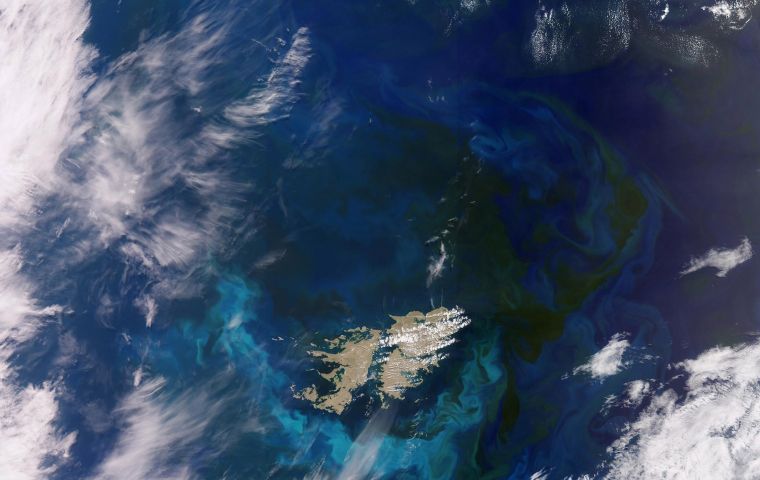MercoPress. South Atlantic News Agency
Germany size algae bloom around Falklands caught by Copernicus sentinel satellite
 The EU's Copernicus Sentinel-3 mission, offers a sweeping view of an algae bloom around the Falkland Islands in the South Atlantic
The EU's Copernicus Sentinel-3 mission, offers a sweeping view of an algae bloom around the Falkland Islands in the South Atlantic The European Union Copernicus Sentinel-3 mission back in November 2023 documented a vast algae bloom around the Falkland Islands, highlighting the interplay with oceanic currents, points out a report from SciTechDaily.
The Copernicus Sentinel-3 mission, part of Europe’s Copernicus program, offers a sweeping view of an algae bloom around the Falkland Islands in the South Atlantic Ocean. Copernicus Sentinel-3 measures systematically Earth’s oceans, land, ice, and atmosphere to monitor and understand large-scale global dynamics.
Algae in the South Atlantic often quickly develop into enormous blooms that float and are carried with the meandering ocean currents. In the image, captured in November 2023, impressive green and blue swirls covering more than 360,000 sq km can be seen around the islands, a area similar to the 357,600 sq km. of Germany. Different colors are the result of sunlight reflecting off the chlorophyll contained in the microscopic plants.
Blooms in this area are quite common owing to the convergence of two strong oceanic currents: the warmer low-nutrient current from Brazil flowing southward and the colder Falkland current that travels northward. When the two currents meet, the resulting turbulence causes upwelling, which can drive large amounts of nutrients to the surface, which is partly responsible for phytoplankton blooms. These blooms are an important food source for many marine species.
The archipelago some 500 from the Argentine coast has two main islands, East and West and hundreds of smaller islands and islets. Helping to map algal blooms and providing critical information for marine operations are just some of the ways that the two Sentinel-3 satellites are used for Europe’s Copernicus program.




Top Comments
Disclaimer & comment rulesCommenting for this story is now closed.
If you have a Facebook account, become a fan and comment on our Facebook Page!